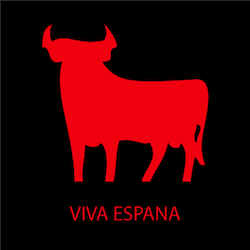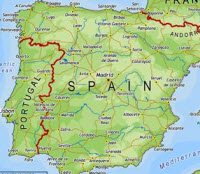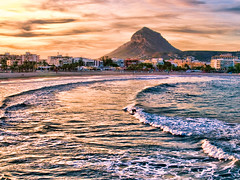 Spain is a very large country, with a long and varied history, and the different provinces are very, very different from each other in terms of culture, history, nature, architecture, food and in some cases even language. We begin this article with a brief summary of its history and an area guide to the most prominent areas of the country. We finish the article with quick facts about Spain.
Spain is a very large country, with a long and varied history, and the different provinces are very, very different from each other in terms of culture, history, nature, architecture, food and in some cases even language. We begin this article with a brief summary of its history and an area guide to the most prominent areas of the country. We finish the article with quick facts about Spain.
History of Spain
Spain's geographical location has contributed to the country's history and development. Spain is located on the Iberian Peninsula in southwestern Europe and has a long coastline facing the Mediterranean Sea and the Atlantic Ocean. The country also has a series of mountain ranges, including the Pyrenees which form the border between Spain and France.
Spain's history is complex and multifaceted, shaped by a range of cultural, political and economic factors over the centuries. One of the earliest known civilizations in Spain was the Iberians, who inhabited the region around 3000 BC. In the following centuries, Spain was invaded and inhabited by various groups, including the Phoenicians, Greeks, Carthaginians and Romans.
Spain was a province of the Roman Empire for over 500 years, and the Romans left a lasting legacy in Spain, including their language, laws and architecture. With the fall of the Roman Empire, the Visigoths took control of Spain in the 4th century AD, and they ruled until the Muslim invasion in the 7th century AD.
Muslim Moors ruled much of Spain for over 700 years, and their culture had a profound impact on Spanish language, art and architecture. The Reconquista, a centuries-long struggle to reclaim Spain from the Moors, was finally completed in 1492, the same year Columbus discovered America. A discovery that would fundamentally change not only Spain, but the whole world.
During the 16th century, Spain became a major European power, with a vast empire that stretched across the Americas, Asia and Africa. The country's wealth and power that arose in the wake of all the goods it imported from the New World allowed it to become a leader in art and culture, with famous writers such as Cervantes and artists such as Velázquez and Goya. For a long period, Seville was the "Capital of the World".
During the 19th and early 20th centuries, Spain underwent significant political and social upheaval, including Napoleon's disastrous invasion, the Carlist Wars, and the Spanish–American War. These conflicts weakened the country's political institutions and led to a period of political instability. The civil war of 1936 was the greatest disaster in its modern history.
During the 20th century, Spain underwent a period of authoritarianism under the dictatorship of General Francisco Franco. Franco ruled Spain with an iron fist for nearly four decades, suppressing political dissent and implementing conservative social policies.
After Franco's death in 1975, Spain transitioned to a constitutional monarchy with a democratic government. The country joined the European Union in 1986 and has since experienced significant economic growth and social change.
Spain is also known for its gastronomy, with a wide range of delicacies from paella to tapas and the famous Spanish wine such as Rioja and Cava. Spain's food culture has been influenced by its geographical location and historical influences from other countries.
Today, Spain is known for its vibrant culture, with a rich tradition of music, art and food. The country is also a popular tourist destination, with millions of visitors each year. But Spain still struggles with political and social challenges, including the ongoing debate over Catalan independence, as well as economic inequality and high unemployment rates (however, Spain seems to be weathering the inflation and energy crisis better than most EU countries). Despite these challenges, Spain remains a fascinating and important country with a rich history and a bright future.
Short guide to Spain - north to south
Barcelona is the Catalan capital famous for La Ramblas, La Familia Sagrada, the football team FC Barcelona, the Gothic old town and exuberant markets. In the vicinity of Barcelona you will find Catalunya (Salvador Dalí's birthplace), the hiking trails on the rugged mountain Montserrat and the seaside resort of Sitges.

Basque Country: The moody people offer, among other things, Spain's culinary capital San Sebastian and the iconic, modern Guggenheim Museum in the capital Bilbao.
Camino de Santiago: This pilgrimage trail with the Swedish name Jacobsleden (the first walk took place in 950) starts in French Le Puy and ends in the cathedral of Santiago de Compostela, the city that is a hub in green Galicia.
Cantabria forms the rustic northern coastal strip of Spain. Here you will find, among other things, world-class prehistoric art (the Altamira caves) and fantastic mountain views from the Picos de Europa.
Salamanca is Spain's number one university city. Many also consider the city to have the country's finest square.
 Madrid : Madrid is not only the political capital but also a main seat of art with the Prado museum among others. In the capital, people are also the best at partying, and do it long and often. Northwest of Madrid are also the cozy and historically interesting cities of Segovia and Àvila.
Madrid : Madrid is not only the political capital but also a main seat of art with the Prado museum among others. In the capital, people are also the best at partying, and do it long and often. Northwest of Madrid are also the cozy and historically interesting cities of Segovia and Àvila.
Toledo is the old capital, now best known for its magnificent cathedral and home mason El Greco.
Andalusia is the heart of the Spanish soul. Here you will find Granada with its fantastic Alhambra Palace , the historic city of Cordoba , Seville with its flamenco and architectural splendor. Between these two regions and the "California of Europe" Costa del Sol lie countless whitewashed villages wedged in the beautiful and undulating landscape.
 The Costa del Sol has the best climate on the mainland in Europe and several lovely old fishing villages that have been transformed into seaside resorts such as Torrox Costa, Torre del Mar and not least the new favorite of the Swedes, Nerja . The capital of the region is Malaga , which has undergone major beautifying changes in recent years with wide avenues and a new marina. To the west of Malaga is the now slightly worn old "Swedish village" of Fuengirola , the seaside resort of Mijas Costa and the eternal jet-set resort of Marbella , where celebrities, luxury yachts, royalty and exclusive fashion brands continue to leave a strong mark on the city.
The Costa del Sol has the best climate on the mainland in Europe and several lovely old fishing villages that have been transformed into seaside resorts such as Torrox Costa, Torre del Mar and not least the new favorite of the Swedes, Nerja . The capital of the region is Malaga , which has undergone major beautifying changes in recent years with wide avenues and a new marina. To the west of Malaga is the now slightly worn old "Swedish village" of Fuengirola , the seaside resort of Mijas Costa and the eternal jet-set resort of Marbella , where celebrities, luxury yachts, royalty and exclusive fashion brands continue to leave a strong mark on the city.
If we go north again along the coast, we eventually pass the unspoiled natural landscape of Costa Calida , and further north lies the Costa Blanca with, among other things, the popular seaside resort of Torrevieja with its famous salt lakes, and the region's capital, Alicante.
 Valencia is known for its modern architecture, oranges, and of course, that this was where the national dish Paella was born. Guide to attractions etc. in Valencia.
Valencia is known for its modern architecture, oranges, and of course, that this was where the national dish Paella was born. Guide to attractions etc. in Valencia.
Facts Spain
Spain is a wonderful country, the Swede knows that, who knows the eternal sun, the happy and pleasant people and the good food. But do you know the facts below?
- Population: about 47 million
- Population density in 2008: 92 inhabitants per square kilometer
- GDP: 1,493,513 US dollars (2012, twelfth on the global list)
- Birth rate: 1.30
- Capital: Madrid
- Internet domain: .ES
- Country code: +34
- Average life expectancy: 82.4 years for women and 78.6 for men
- National Day: 12 October
- National Anthem: Marcha Real
- Highest point: Teide in Tenerife which is 3718 meters above sea level
- Highest recorded temperature: Murcia, 47.2 Celsius (July 4, 1994)
- State: Parliamentary monarchy
- Largest city (population) Madrid (second largest city is Barcelona and Valencia is third largest city)
- Major religion: Catholicism
- Largest economic sectors: tourism, chemical products, industrial goods, fashion, components for the construction industry
- Mainland time zone: Central European Time (o hours time difference to Sweden)
- Currency: Euro
- Area: 504782 square kilometers
Spaniards will soon live the longest in the world
According to a survey conducted by Washington University in 2023, Spain will have the highest life expectancy in the world in 2040 (ahead of Japan). In 2066, the country is expected to have as many as 220,000 centenarians! There has already been a lot of discussion about the fact that the Spanish average life expectancy is positively affected by its diet consisting of very fresh olive oil (the olive oil we have in Sweden can hardly be compared!) fresh fruits and vegetables, proximity to the sea, and many hours of sunshine
Provinces:
Asturias, Madrid, Cantabria, La Rioja, Navarra, Biscay, Barcelona, Gipuzkoa, Alicante, Murcia, Álava, Almería, Málaga, Castellón , Pontevedra, Cádiz , Granada, Girona , Tarragona, Huelva, León, Burgos, Toledo, Albacete, Huesca , Zaragoza, Teruel, Valladolid, Las Palmas, Ciudad Real, Seville, Orense, Salamanca, Soria, Ávila, Badajoz, Jaén, Valencia, Córdoba, Cuenca, Lleida, Segovia, Lugo, Santa Cruz de Tenerife, La Coruña, Guadalajara, Cáceres , Zamora, Palencia, the Balearic Islands ( guide to Palma, and guide to the rest of Mallorca ).






